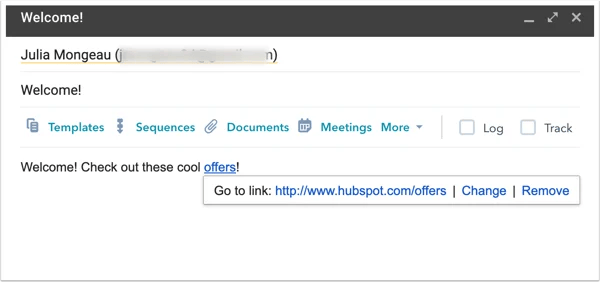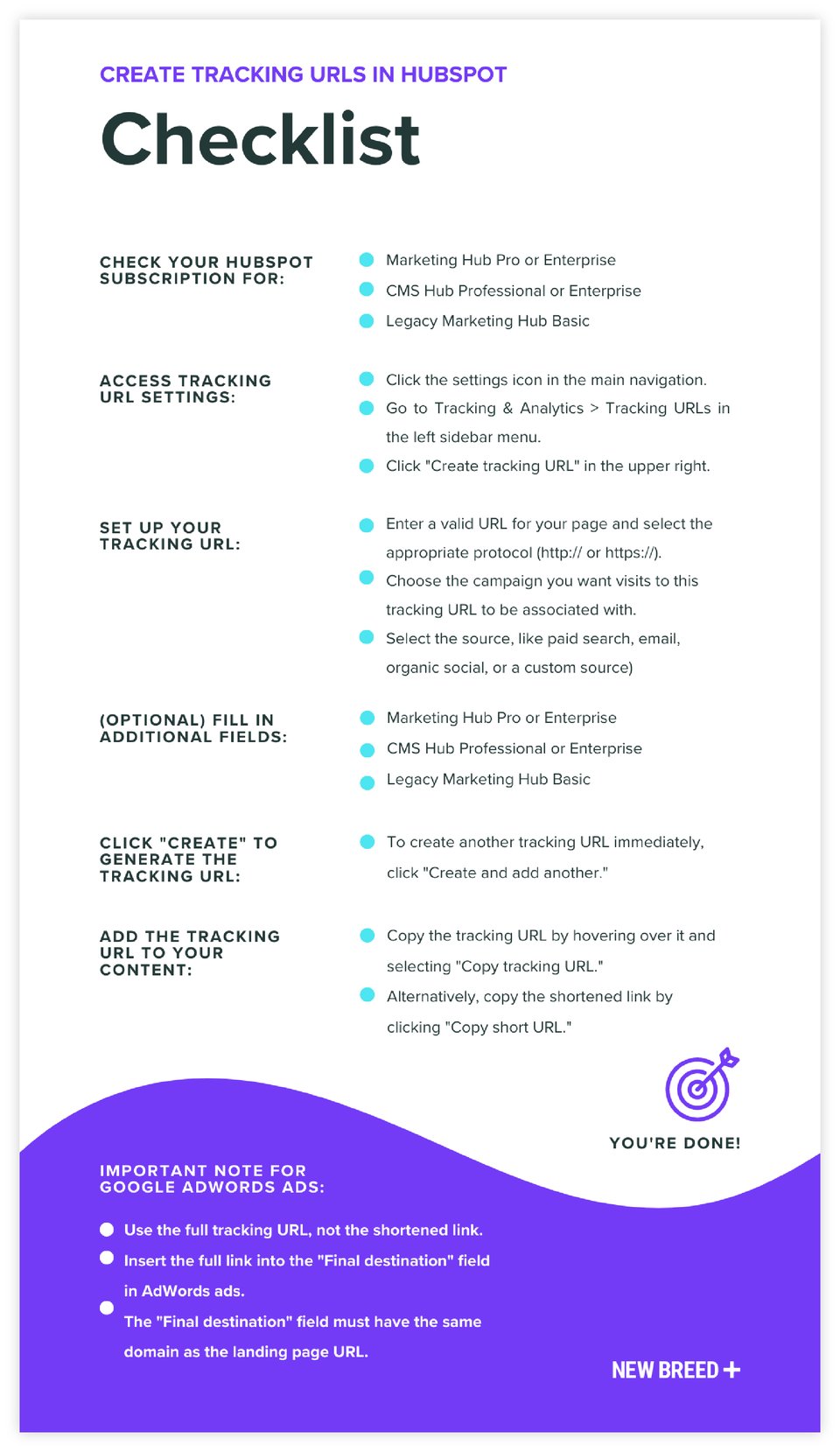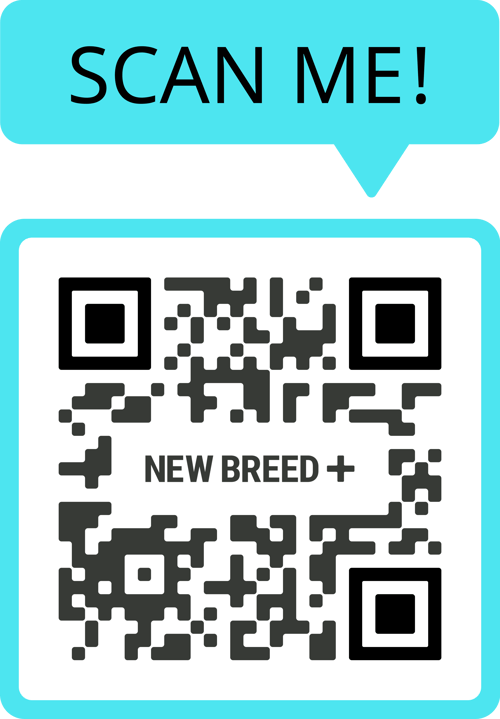Best Practices for Link Tracking in HubSpot (+Checklist)
Link tracking isn't just for reporting on your HubSpot campaigns—it's a powerful tool for onboarding, optimization, and revenue attribution. By understanding which of your campaigns are driving the most traffic and which sources are most effective, you can refine your digital marketing strategy to focus on what's working and improve what isn't.
This might involve investing more in a successful marketing channel, tweaking your content to better appeal to your audience, adjusting your campaign parameters for better tracking, or improving all activities that elevate your brand positioning or lead generation strategy.
What is a Tracking URL?
A tracking URL is a modified standard URL featuring specific parameters that help capture vital data about your visitors. When a prospect engages with your content—be it an email, a pay-per-click ad, a social post, or a landing page—and lands on your website, the tracking URL steps in.

Tracking URLs provide a direct link between your marketing efforts and revenue generation by allowing you to track a visitor's journey from the moment they click on a campaign to the point of conversion.
For example, when you use a unique tracking URL in a newsletter, you can trace who clicked on the link, how they engaged with your website, and whether or not they filled out a form or eventually became a long-term customer. You can also set up trigger events based on clicks, session time, or conversion point in Hubspot.
.png?width=1904&height=240&name=pako_eNqNkdtOwzAMhl_Fyg2btL1AL0Bbu5O0IbQDEmq4MKnXRmsTlGRDo9u742YgIa64imN_-X_HboWyBYlE7Gv7oSp0AZZraUa93rP2OljX78NweH9Ja60OHqyBrUN10KaE3Xp5gXH--_4qzbjDIW132xU8ocOGAjkPGR8qUHGVJo1Eln8b3HlYmL11DQbN8htOUcFCWcQmbWrNiRW62uREJtwaoOKBpSbMwAv5iE7%20(1).png)
Can you track who clicks on a link?
With the right tools, you can track general information about who clicks on a link, such as their geographical location, the device they used, and the time they visited. However, due to privacy laws, personally identifiable information (like name, email, etc.) can only be tracked with explicit user consent.
Structure of a tracking URL
The unique parameters attached to the URL gather key insights about your visitor's journey. Let's take a closer look at the components that make up a tracking link:
- Base URL: The standard URL of the page you want to track. For example, https://www.yourwebsite.com/
- Question Mark (?): Used after the base URL to begin the query string, which contains the tracking parameters.
- UTM Parameters: These are the specific tracking parameters appended to the base URL. They start with "utm_" (stands for Urchin Tracking Module, a format popularized by Google Analytics) and provide specific information about the source, medium, and campaign name. Most commonly used codes are:
-
- utm_source: Source of your traffic such as a search engine, newsletter, or other referral.
- utm_medium: Medium the link was used on such as email, social media, or cost-per-click.
- utm_campaign: Specific campaign or promotional effort driving the traffic.
- Ampersand (&): This is used to separate different UTM parameters in the URL.
So, a tracking URL might look something like this:

The URL indicates that the visitor clicked on a link from an email in your "spring_sale" campaign. This email was sent through your newsletter.
Remember, specific UTM parameters you use can be customized based on your tracking needs. Other parameters you may encounter include:
- "utm_term" to track keywords in paid search campaigns
- "utm_content" to differentiate similar content within the same ad or other campaign
Pro tip: UTM parameters should be used with discretion. Having too many UTM parameters can make URLs difficult to manage, and make the link look suspicious to users. On the other hand, having too few can lead to a lack of data for making informed decisions. Find a balance for your go-to-market needs.
Tracking URLs in HubSpot
HubSpot's URL tracking tool, available in Pro and Enterprise tiers, is designed to help you trace the paths of your visitors. The platform's click tracking works by adding UTM parameters to your URLs. The tracking code, which is a piece of JavaScript code that you add to your website, enables this process.
![]()
Worth noting—with the latest UTM building updates, you can now conveniently manage UTM parameters directly within HubSpot. This streamlined process saves you time and effort, allowing for seamless analysis of your campaigns.
Create a tracking URL in HubSpot
Keep in mind, free HubSpot users cannot use tracking capabilities. Here are the steps to setting up URL tracking in HubSpot CRM for Pro and Enterprise users:

How to Analyze Your Campaign Tracking Data
After making tracking URLs and adding them to your content, the important next step is to analyze the collected data. You can track clicks, understand user behavior, and even update a contact record or custom object in HubSpot based on the collected data. In other words, you're able to track the end-to-end efforts of your demand generation strategy.
Tracking URLs in HubSpot's traffic analytics tool
You can access your URL tracking data by using HubSpot's Traffic Analytics tool. To analyze the data from a specific tracking URL, navigate to Traffic Analytics from your dashboard and filter by campaign. This indicates the performance of your tracking URLs, including the number of clicks received and the sources of your traffic.
5 metrics and benchmarks to assess performance
Interpreting the data involves understanding the different KPIs available and how they can be used to measure the performance of your campaigns. Here are some key metrics to track:
- Number of Clicks: How many times your tracking URL was clicked, giving you an idea of the popularity of your content. A high click number generally indicates that your content (or at least the CTA!) is engaging and relevant to your ICP and target personas.
- Source Data: Shows where your traffic comes from, like social media, email marketing, organic search, or other sources. The majority of your traffic should ideally come from your targeted channels.
- Bounce Rate: Percentage of visitors who leave your site after viewing only one page. A high bounce rate could indicate that your content is not meeting the expectations of your visitors.
Based on data from Databox benchmarking, B2B companies typically experience a bounce rate of around 63%. However, top companies in the group achieve a bounce rate under 40%.
4. Conversion Rate: The percentage of visitors who complete a desired action on your site, such as filling out a HubSpot form or making a purchase. As another benchmark example, B2B companies that run Google Ads typically achieve a conversion rate of around 4.25%.
5. Average Session Duration: Average time visitors spend on your site during a single visit. A longer session duration suggests that visitors are finding your content engaging and valuable. Website sessions typically last one minute—which means you have a short time to capture and maintain a visitor's interest.
What's a good conversion rate?
A high conversion rate indicates that your content is effectively persuading visitors to take action. A good conversion rate can vary greatly depending on your industry, ICP, and the specific action or goal, but 2-5% is often considered the average conversion rate.
By tracking this metric, you'll be able to identify opportunities to optimize your campaigns and improve your activities.
A note on privacy and data protection
To protect user privacy and follow data protection rules like GDPR (even for US companies), it should be top of mind to handle URL tracking data responsibly. This includes obtaining necessary consents from users, anonymizing data where possible, and ensuring that data is securely stored and processed.
Best Practices for Link Tracking
To get the most out of HubSpot's tracking URL capabilities, here are a few best practices to follow:
Implement parameters consistently
The parameters used in a tracking URL need to be consistent for accurate data analysis. Using 'email' in one campaign and 'Email' in another can lead to confusion as analytics tools often treat these as separate mediums due to case sensitivity.
To avoid this, maintain a standardized naming convention across all campaigns. Consistent parameter usage ensures that your data is neatly organized and easily interpreted. If you're working with a team, establish clear guidelines and keep up with training/check ins to ensure everyone follows the same practices.
Don't forget canonical tags
If you have identical or very similar content on different URLs, you may confuse search engines, leading to lower SEO rankings.
Canonical tags can help by specifying which URL is the "main" one. This way, even if tracking parameters create multiple URLs for the same page, search engines know which one to prioritize. In HubSpot, you can edit a page's canonical URL in its advanced settings. This helps avoid confusion caused by tracking data from duplicate pages.
Pro Tip: If you use the same tracking URL across multiple campaigns or channels, you'll struggle to pinpoint which one is driving the most traffic or conversions. Create different links for each. With unique URLs, you can easily identify top-performing campaigns and those that might need a little extra attention.
Set up redirects properly
Redirects are used to send users and search engines to a different URL from the one they originally requested. This is useful when a page's URL has been changed. In HubSpot, you can set up redirect chains from any URL on a HubSpot-hosted domain to any other link. This guarantees the link trace is associated with the correct page, even if its URL itself has been changed.
Use URL shorteners
URL shorteners can make your links more manageable and visually appealing — and yes, many URL shorteners preserve UTM parameters. When you shorten a URL that includes those parameters, the short URL should redirect to the original URL, including the full code sequence.
HubSpot has a built-in URL shortener tool, and you can also use a third-party URL shortener like Bitly or TinyURL to shorten your URLs before using them in your campaigns. When these tools shorten the original URL link, they automatically incorporate the code. This means that you can still obtain the tracking information from the UTM code, even if it is not visible to you.
Pro Tip: Note that some URL shorteners may also obscure the destination link. This can sometimes lead to issues with user trust, as people might be hesitant to click on a link when they can't see where it leads.
Integrate HubSpot content with Google Analytics
Linking the two platforms via the native integration allows you to analyze the data from different perspectives, such as traffic sources, behavior flow, and conversion rates. You can add Google Analytics tracking code to a domain, blog, or any page on your website.
Install HubSpot tracking code on external pages
The HubSpot tracking code is unique to each HubSpot account and allows HubSpot to monitor your website traffic. The tracking code is automatically included on HubSpot blog pages, landing pages, and website pages.
If you have any externally hosted pages (i.e., main site pages or campaign-specific landing pages not on HubSpot), you must install the HubSpot tracking code manually to capture analytics for those pages. Other examples of such pages or external platforms may include:
- WordPress (though you may also use the plug-in)
- Shopify
- Drupal
- Wix
- Magneto
- Squarespace
- Google Tag Manager
Track offline channels with QR codes
URL tracking is not limited to digital channels. You can also utilize it for tracking offline promotion efforts.
For example, create unique tracking URLs via QR codes for print advertisements, direct mail campaigns, or billboards. Simply include a custom QR code on print material and incentivize folks to scan the code with their smartphones, and you'll be able to track it from there. Try it below!

FAQs on link and click tracking
- What information does link tracking provide in HubSpot? Link tracking in HubSpot provides comprehensive data about visitor behavior. This includes the source of the traffic, the medium through which they found your link, the campaign associated with the traffic, and individual user engagement with your web content.
- How does a click tracker work? A click tracker works by using a tracking URL, which is a standard URL with additional parameters (or specifications on the campaign it's attached to). When a user clicks on this link, the analytics tools capture the information, giving you a clear view of the buyer's journey from the point of clicking to conversion.
- What tool tells you where people are clicking on your pages? Is that the same as URL tracking? Heat mapping tools can tell you where people are clicking on your web pages, providing a visual representation of user activity. While related, this is different from URL tracking, which records the sources and behavior of visitors who arrive via specific links. Both tools are useful for understanding user behavior and optimizing your website.
- How do I track clicks on Google sites? To track clicks on Google sites, you can use Google Analytics or Google Tag Manager. Both tools allow you to analyze user behavior on your site, including the number of clicks on a particular URL, the source of the traffic, and other important metrics.
- How do I track clicks on a link in an email? You can track clicks on a link in an email by embedding a tracking URL in the email. The data collected from these clicks can be viewed in your email marketing platform or integrated analytics tool, such as HubSpot CRM or Google Analytics.
The Takeaway
Effectively tracking URLs involves consistent application, regular analysis, and frequent adjustments. But the benefits it brings in terms of visitor data, campaign optimization, and improved conversions are well worth the effort.
But remember, link tracking is just one tiny aspect of the full potential of your CRM. That's why we've compiled the HubSpot Implementation Checklist. This guide covers every step you need to take, from setting up your account to launching your first campaign, and all the tweaks to the system from there.
Whether you're new to the platform or you've been using it for a while, this checklist can serve as your roadmap to successful CRM implementation.
Baili Olive
Baili is a Senior Search Strategist at New Breed, holding multiple certifications including HubSpot's SEO, Digital Advertising, SEMRush, and Google Ads. Her expertise spans across SEMrush, HubSpot Marketing Hub, Social Media Marketing, and Digital Marketing, with a particular focus on Google Ads, Google Data Studio,...





